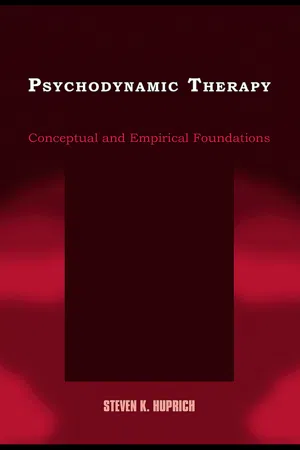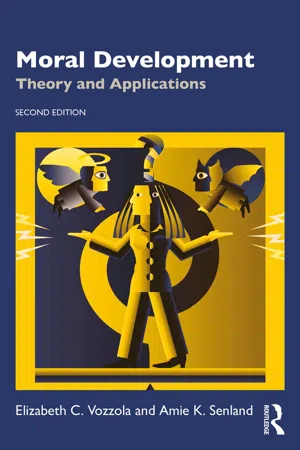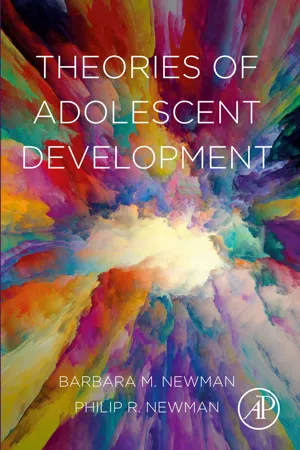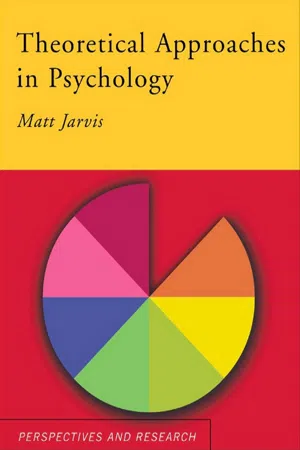Psychology
Psychodynamic Theories and The Moral Component
Psychodynamic theories emphasize the role of unconscious processes in shaping behavior and personality. The moral component within psychodynamic theories refers to the internalized moral standards and values that guide an individual's behavior. This component is influenced by early childhood experiences and the development of the superego, which represents the internalization of societal and parental moral standards.
Written by Perlego with AI-assistance
Related key terms
10 Key excerpts on "Psychodynamic Theories and The Moral Component"
- eBook - ePub
- Sarah Sifers(Author)
- 2011(Publication Date)
- Collins Reference(Publisher)
Although, as The History of the Problem of Abnormal Behavior suggests, early indications of a psychodynamic approach to abnormal behavior began to appear in the late nineteenth and early twentieth centuries, the full sweep of the perspective comes out of the clinical practice and writings of Sigmund Freud, whose work began in the latter half of the nineteenth century and ended in 1939. His profound contributions have been extended and modified by early disciples and thereafter by neo-Freudians and by ego psychologists.Basic Concepts of the Psychodynamic Perspective
Key to an understanding of the perspective is an understanding of the word psychodynamic. From the dictionary comes this definition: “the interaction of various conscious and unconscious mental or emotional processes, especially as they influence personality, behavior, and attitudes” (American Heritage Dictionary, 2004).Psychoanalysts and other psychodynamic theorists typically specify that definition to include the importance of early life experiences in determining adult characteristics.Almost universally, members of the psychodynamic school identify three basic concepts underlying the psychodynamic perspective: psychic determinism, unconscious motivation, and the role of childhood experiences.Psychic Determinism
Psychodynamic theorists believe that although we have a sense of freely choosing what we will think about, desire, and do, much of our behavior actually is determined for us or at least strongly influenced by earlier life experiences.Unconscious Motivations
Motivational forces operate, to a considerable degree, at an unconscious or, at most, preconscious level. The psychodynamic theorists hold that the full basis for significant behavior, especially for motivation, is largely unknown to the affected individual. This belief significantly influences psychotherapeutic techniques, which are discussed in Psychodynamic Forms of Psychotherapy.Childhood Experiences
The individual is most vulnerable to influences from the environment during the early years of life. For these reasons, most, but not all, psychodynamic thinkers believe that critical dynamic forces influential throughout the lifespan of the individual are developed during the early years of childhood. This principle of the psychodynamic perspective also has an important influence on treatment approaches, especially on psychoanalytically oriented treatment. - eBook - ePub
Psychodynamic Therapy
Conceptual and Empirical Foundations
- Steven K. Huprich(Author)
- 2010(Publication Date)
- Routledge(Publisher)
Section I Theoretical UnderpinningsPassage contains an image
2Basic Principles of Psychoanalytic and Psychodynamic Theory
Although psychoanalytic theory and its implication for treatment have evolved substantially over time (Frank, 2000; Kernberg, 1993; Marcus, 1999; Pine, 1998; Rangell, 1981; Wallerstein, 1989, 2002), certain principles remain as guiding elements as part of any discussion of psychoanalytic or psychodynamic psychotherapy. As noted in Chapter 1 , these are summarized by Westen (1998, pp. 334–335):1. Much of mental life—including thoughts, feelings, and motives— is unconscious, which means that people can behave in ways or develop symptoms that are inexplicable to themselves.2. Mental processes, including affective and motivational processes, operate in parallel so that, toward the same person or situation, individuals can have conflicting feelings that motivate them in opposing ways and oft en lead to compromise solutions.3. Stable personality patterns begin to form in childhood, and childhood experiences play an important role in personality development, particularly in shaping the ways people form later social relationships.4. Mental representations of the self, others, and relationships guide people’s interactions with others and influence the ways they become psychologically symptomatic. 5. Personality development involves not only learning to regulate sexual and aggressive feelings but also moving from an immature, socially dependent state to a mature, interdependent state.It is perhaps these five principles that best distinguish psychodynamic and psychoanalytic psychotherapy from other forms of treatment that are commonly practiced today, which focus mainly on conscious cognitions, behavior change, and symptom reduction. Psychotherapy process also is part of psychoanalytic and psychodynamic theory, unlike many of the common therapies espoused to be empirically superior. Issues of how the patient responds to the therapist, how the therapist responds to the patient, how and when a person resists a particular topic of investigation, and how all these processes change in the course of the session are part of understanding and conducting sound psychodynamic and psychoanalytic treatment. - eBook - ePub
Moral Development
Theory and Applications
- Elizabeth C. Vozzola, Amie K. Senland(Authors)
- 2022(Publication Date)
- Routledge(Publisher)
are factually wrong, many of its assumptions and implications are quite insightful and we forget them at our peril” (p. 210).Anyone who has taken an upper-division class in psychology or a graduate class in the helping fields is likely to have been exposed to Freud's basic model of personality—the id, the ego, and the super-ego (Freud, 1923, 1930). Rather than rehash the summary and surface treatment many of you have read in multiple formats, we concentrate on modern thinkers who have examined morality from a psychoanalytic framework. We believe you will be pleasantly surprised to see that neoanalytic thinkers provide some provocative insights with important implications for parents and professionals.These newer ideas were not, however, evident in the first comprehensive moral development textbook (Lickona, 1976 ). In that book, psychiatrist James Gilligan laid out the classic psychoanalytic position that morality represses individuals. For Gilligan (1976) , Freud's theory marked the beginning of the scientific rather than philosophical investigation of morality:A psychoanalytic theory of moral experience sees morality as a force antagonistic to life and to love, a force causing illness and death—neurosis and psychosis, homicide and suicide. I see morality as a necessary but immature form of affective and cognitive development, so that fixation at the moral stage represents developmental retardation, or immaturity, and regression to it represents psychopathology.(p. 145)Here, morality is viewed as being motivated by shame and guilt and may be contrasted with the goal of psychoanalysis—a level of healthy functioning in which individuals are motivated by the positive desire to love. Ethics tends to tell people what to do; psychoanalysis aims at asking people what they want - eBook - ePub
- Barbara M. Newman, Philip R. Newman(Authors)
- 2020(Publication Date)
- Academic Press(Publisher)
Delgado, 2008 ):- 1. The central importance of the unconscious in mental functioning
- 2. Recognition of the symbolic meaning of behaviors, including the symbolic meaning of symptoms
- 3. The existence of internalized unconscious conflicts
- 4. The belief that transference-based thought and behavior are critical for understanding these conflicts
Even contemporary approaches to psychotherapy that do not adhere to a traditional psychoanalytic model of therapy apply certain basic concepts from Freud’s approach including an assumption of unconscious motivation, defense mechanisms, resistance, and transference (Safran, 2012 ).According to psychoanalytic theory, parenting and the quality of parent-child interactions are the basic contexts for determining the person’s ability to manage impulses, get along with others, establish adaptive or maladaptive behavior patterns, and experience anxiety, guilt, or self-confidence and self-esteem. In psychoanalytic theory, one’s primary caregivers (e.g., parent, parents, or guardians) are the most important people in the child’s social environment. They are the primary love objects. They are also a primary source of fear through their real or imagined retaliation for the expression of unacceptable wishes. Adolescents’ ideas about the acceptability of various forms of drive satisfaction are thought to originate from the way parents react to their child’s pleasure-seeking behaviors. Through identification with parents or other close caregivers, adolescents incorporate the social standards and moral principles of their community. As part of the second individuation process, adolescents may experience feelings of anxiety as they reexamine or abandon some of these internalized standards. With the reawakening of the dynamics of the Oedipal or Electra conflicts that accompany puberty, adolescents face new and intense sexual and aggressive impulses that challenge their established coping and defensive strategies. Exploration of the adolescent’s fantasy life, imagination, and preoccupation with invented video, television, literary, or gaming scenarios provide a context for understanding the expression and gratification of these drives. - eBook - ePub
- Rob Leiper, Michael Maltby(Authors)
- 2004(Publication Date)
- SAGE Publications Ltd(Publisher)
Since the 1980s there has been a growing acceptance of the legitimacy of the diverse positions within the psychodynamic arena. The tendency to either overemphasise or downplay differences has been lessened. There has been increasing acceptance of a situation of pluralism in which a number of major positions exist, each with its own traditions and key theoretical contributions. Perhaps these are not amenable to any easy resolution, but this acceptance of difference allows greater clarity about which differences are substantive and which are more a matter of appearance or language. The main lines of historical debate can now be viewed more dispassionately and placed in terms of their contribution to the present day. Broadly speaking, these disputes have existed with regard to two major issues in psychodynamic theory: the nature of motivation and the roots of psychopathology. The evolving positions on these issues provide a glimpse of the different models of human action that have been developed by some of the key contributors to psychodynamic thinking.Figure 2.3 The developing theoretical field of psychodynamicsThe nature of motivation
An important element of Freud’s original vision was a model of motivation based on the operation of instinctual drives that underlay a person’s relationship with the world. It was what has been called a ‘hydraulic model’: instinctual pressure builds up and is relieved through discharge. The relief of this tension was the aim of the drive whether this was sex or hunger or aggression. ‘Objects’, whether people or things, were required to fulfil this aim and patterns of behaviour and relationship were constructed through learning how to achieve this. The crucial drive in this process was, as reflected in the developmental theory, sexual. ‘Libido’ (the Latin for desire), however, was regarded in quite a broad sense; it covered a wide array of body-based relationships with the world. Later, partly in response to the criticisms of Adler, the place of aggression as a drive was elevated to an equal position and each of these concepts generalised to be encompassed in a polarity between ‘life’ and ‘death’ instincts. Although the language of instinct remained in place, it evolved in use from its original physiological emphasis.In fact, questions about the nature of libido were being asked early on. They were a major source of the split with Jung, who abandoned the sexual, drive-based conceptualisation of libido for a more encompassing idea of creative energy reaching out for connection to the world. Jung (1934/1981) came to understand the form of that connection as structured through various transpersonal forms or ‘archetypes’ that were intrinsic to the human psyche in general. Although often not recognised as such, this broadening of the libido concept was the beginning of one of the major lines of development in psychodynamic thought: the nature of the relationship to the ‘object’ where this is a person. Starting in Freud’s later writings and developed by Klein and others, a central place in understanding the structure and functioning of the psyche was given to the form in which relationships with people (particularly parental caregivers) were internalised to become the building blocks of inner reality. Initially conceived in terms of relationships produced through the functioning of the instinctual drives (hence the use of the term ‘object’) writers such as Fairbairn (1952) in Britain and Sullivan (1953) in America, proposed that there was instead an autonomous need for human relationship independent of the satisfaction of physiological needs. The human infant is seen as intrinsically ‘object-seeking’ and development is, more than anything else, the playing out of this need and the anxieties and difficulties associated with it: the self always evolves as part of a human relationship and the internal world is built out of this interplay. - eBook - ePub
Counseling Children and Adolescents
Connecting Theory, Development, and Diversity
- Sondra Smith-Adcock, Catherine Tucker, Sondra Smith-Adcock, Catherine Tucker(Authors)
- 2016(Publication Date)
- SAGE Publications, Inc(Publisher)
The various individuals who gave us psychodynamic theories harbored quite an array of beliefs about the nature of human beings, their problems, and how problems should be addressed in therapy. For example, Sigmund Freud was generally regarded as a pessimist who believed that human nature was determined and fixed by early experiences and environment (Wallerstein, 1995). On the other hand, Carl Jung and Alfred Adler saw human nature as malleable into adulthood and heavily influenced by social connections (Adler, 1964; Jung, 1964). What all of the psychodynamic theories do have in common is the belief that people’s problems exist at least in part in the un- or subconscious mind (Murdock, 2013).Freud and the attachment theorists, including John Bowlby and Mary Ainsworth, created theories based largely on the neurobiological understanding of the human brain (Karen, 1998). Attachment and psychoanalytic theorists also share a belief in the power of early experiences to influence behavior throughout the lifespan. While the attachment theorists studied how the trauma of inappropriate caregiving of young children caused later problems in the organization of a child or adult’s emotions and actions, psychoanalysts looked to problems in a person’s psychosexual development for the causes of neurosis or psychosis. Both groups believe that much of the motivation for a person’s behavior is not within his or her conscious awareness and must be carefully uncovered in order to identify the source of the trouble and move past it (Wallerstein, 1995). The methods of reaching and treating these hidden memories and impulses were matters of great debate among the early theorists (Murdock, 2013).Sigmund Freud, Anna Freud, and Melanie Klein
Although Sigmund Freud only saw perhaps one child for one session of therapy, Little Hans, whose treatment is outlined in his 1909 publication, Analysis of Phobia in a Five-Year-Old Boy - eBook - ePub
Becoming a Counsellor
A Student Companion
- Kirsten Amis(Author)
- 2011(Publication Date)
- SAGE Publications Ltd(Publisher)
Neurosis: Unhealthy behaviour which is in the conscious – the client is aware of it (e.g. depression and phobias). Interestingly, obsessive compulsive disorder (OCD), although mainly neurotic, can also present with psychotic features. The ego remains unharmed.- Psychosis: Unhealthy behaviour which is unconscious – the client is unaware of it (e.g. hallucinations and delusions). There is a loss of awareness of reality.
Putting theory into practice
In addition to Freud’s original theory, there are many other psychodynamic theorists who have built upon his original ideas. Carl Jung, Alfred Adler, John Bowlby, Melanie Klein, Erik Erikson, Donald Winnicott, Karen Horney and Erich Fromm are just some of the influential intellectuals influenced by the underlying philosophy of the psychodynamic tradition. As with many models, some overlap more than one school of psychology, such as Eric Berne’s transactional analysis, which can be viewed as both psychodynamic (ego states) or humanistic (positive self-regard, organismic valuing). Fitz Perls’ Gestalt therapy is similar in that it bridges psychodynamic (recognition of unconscious forces) and humanistic schools (present rather than past). All of these approaches have their own blend of values, skills and methods that best serves their needs and often require a more long-term approach to the therapeutic alliance.Despite being criticised and discredited over the years, it is now recognised that Freud’s psychoanalytical theory has influenced the majority of contemporary counselling, and much of Freud’s language and terminology is still in use today. His multi-dimensional ideas have evolved into successful working models of therapeutic practice.COGNITIVE BEHAVIOURAL THERAPY
Behavioural psychology – J. B. Watson (1878–1958), B. F. Skinner (1904–1990), Ivan Pavlov (1849–1936)
Often referred to as the ‘second force’, behaviourism removed the focus from the inner workings of the mind where Freud had placed such importance, and relocated it to actions and observable behaviours. This more empirical, scientific approach dismissed the significance of thoughts and feelings and replaced them with objective, measurable outcomes. To do this, experimentation became the principal technique, and because no discussion was necessary (monitoring sufficed) animals could be utilised as well as humans, although many behaviourists then applied the results to human behaviours. Examples of behaviourist theories are ‘classical’ and ‘operant conditioning’. During this period, ethical guidelines did not exist in the same way that they do today, so some experiments are considered inhumane and unethical in retrospect. There are basic assumptions purported, such as that we are born as a blank slate. If behaviour can be learned, it can be unlearned; there is a relationship between trigger (stimulus) and our response which can be manipulated. - eBook - ePub
Foundations of Counseling and Psychotherapy
Evidence-Based Practices for a Diverse Society
- David Sue, Diane M. Sue(Authors)
- 2012(Publication Date)
- Wiley(Publisher)
To address current modifications, we will focus more on psychoanalysis as it is practiced today. We will use the terms, psychodynamic or psychoanalytic, to designate modified forms of psychoanalysis. In this chapter, we will first present the different models of psychodynamic theory and discuss how they have evolved over time. Second, we will consider the different techniques used in psychodynamic therapy and the research findings associated with each. Third, we will consider effectiveness studies with the more recent psychodynamic therapies. Finally, we will indicate how the diversity perspective can be incorporated within the psychodynamic framework. In Chapter 7, we will also describe in detail the steps involved in Core Conflictual Relationship Theme Therapy, a brief manualized 16 session treatment, with the goal of giving readers an understanding of the process and assumptions involved in this type of therapy. Interpersonal Therapy (IPT), an empirically supported therapy for depression, which is often described as a form of psychodynamic therapy, will be covered in Chapter 8. The Evolution of Psychodynamic Theory Psychodynamic theory has evolved over time as indicated by five distinct models (Hansen, 2000; Robbins, 1989; and Todd & Bohart, 1999). The first two, drive and structural/ego models, are traditional models characterized by positing human behavior as attempts to express, gratify, or defend against instinctual drives. Human behavior and interpersonal relationships are said to derive primarily from sexual or aggressive impulses. This intrapsychic (i.e., within the individual) orientation also influenced the tenets of the therapy. The therapist is not considered to be part of the “field” in psychotherapy with a client but exists merely as an observer. Under the drive and ego/structural models, the therapist is neutral and objective, functioning as a blank screen onto which clients project their instinctual conflicts - eBook - ePub
- Matt Jarvis(Author)
- 2005(Publication Date)
- Routledge(Publisher)
events to the unconscious mind, and by unconscious motives. Although consciously, Alex thought she was taking her sister to sea for a birthday treat, the event seems to have quite a different meaning to her unconscious mind. We might even wonder whether Alex was motivated on an unconscious level to take her sister to sea again in order to kill her.- In contrast to other branches of psychology which place a strong emphasis on systematic, scientific research,
psychodynamic psychology looks for information in dreams, symptoms, irrational behaviour and what patients say in therapy.(Adapted from Rycroft, 1968; Tavris and Wade, 1997; Jarvis, 2000)If you know very little about psychology, and you have heard of just one psychologist, the chances are that this is Sigmund Freud, the founder of the psychodynamic approach to psychology, or psychoanalysis. If Freud (or at least Freud as he is popularly portrayed) represents your layperson’s idea of psychology then you probably have an image of a patient lying on a couch talking about their deepest and darkest secrets. In deliberate contrast to behavioural psychology, examined in Chapter 2 , psychodynamic psychology ignores the trappings of science and instead focuses on trying to get ‘inside the head’ of individuals in order to make sense of their relationships, experiences and how they see the world.In this chapter we can look at the work of Freud and that of one other influential psychoanalyst, Donald Winnicott. We can then look at how psychodynamic principles have been applied in the field of mental health, and use them to try to understand the popularity of monsters, a seemingly irrational phenomenon common throughout history and common to many cultures.Freud’s theories
Sigmund Freud (writing between the 1890s and the 1930s) developed a collection of theories which have formed the basis of the psychodynamic approach to psychology. His theories are clinically derived—i.e. based on what his patients told him during therapy. Freud theorised on a wide variety of topics and developed his ideas throughout the period of his writing. It is not possible to overview all or most of Freud’s ideas in this chapter, but we can look briefly at a few of Freud’s more important contributions. - eBook - ePub
- Talcott Parsons(Author)
- 2010(Publication Date)
- Free Press(Publisher)
THEORETICAL PERSPECTIVESPassage contains an image
1The Superego and the Theory of Social Systems
I N THE broadest sense, perhaps, the contribution of psycho-analysis to the social sciences has consisted of an enormous deepening and enrichment of our understanding of human motivation. This enrichment has been such a pervasive influence that it would be almost impossible to trace its many ramifications. In the present paper I have chosen to say something about one particular aspect of this influence, that exerted through the psychoanalytic concept of the superego, because of its peculiarly direct relevance to the central theoretical interests of my own social-science discipline, sociological theory. This concept, indeed, forms one of the most important points at which it is possible to establish direct relations between psychoanalysis and sociology, and it is in this connection that I wish to discuss it.Psychoanalysis, in common with other traditions of psychological thought, has naturally concentrated on the study of the personality of the individual as the focus of its frame of reference. Sociology, on the other hand, has equally naturally been primarily concerned with the patterning of the behavior of a plurality of individuals as constituting what, increasingly, we tend to call a social system. Because of historical differences of perspective and points of departure, the conceptual schemes arrived at from these two starting points have in general not been fully congruent with each other, and this fact has occasioned a good deal of misunderstanding. However, recent theoretical work1
Learn about this page
Index pages curate the most relevant extracts from our library of academic textbooks. They’ve been created using an in-house natural language model (NLM), each adding context and meaning to key research topics.









